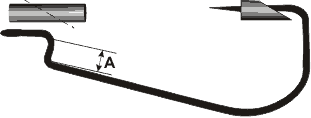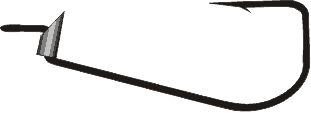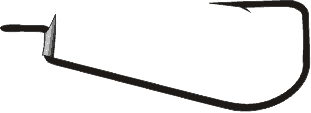Rebarbing a Texposer (or other offset shank) Worm Hook
Next to setting the hook, the bane of the average soft plastic lure fisherman is keeping the lure rigged straight. Time was, when most Texas rig fishermen (myself included) pegged the lure to the hook eye with a toothpick. In extremely heavy cover, this is still an option, at least with worms/lures that are meaty enough to handle the toothpick without excessive damage. But it's also time consuming. Find a toothpick, insert it, clip it flush, etc. Just one more thing to do every time you rerig or replace your worm.
Of course there are hooks that have barbs on the shank, but those barbs have always seemed to me to do very little. Most are actually way too far down the shank to even contact the worm when it's rigged right.
The offset ("Z-bend") style worm hook that most fishermen prefer to use today does help a bit. But even when super-gluing the worm to the kink in the hook shank, I find myself re-rigging and adjusting the worm too often for my taste.
That's where rebarbing comes in. Rebarbing is simply using a piece of heat shrink tubing to add a barb to the front of the hook to help hold the worm on. Although some west coast fishermen have been doing this with straight shank hooks for a number of years, I prefer a variation of it with bent or offset shank worms that I've found to really work well. It's especially valuable in flipping heavy cover where a heavy slip sinker is always trying to push the head of the worm back. And for lures like the Lunker City Salad Spoon, which are used in heavy cover, but rely on a very streamlined nose section as part of their design, or for ludicrously soft plastics like Yamamoto's Senko, it's a night and day difference.
| Here's how to do it... |
Get some 1/16" ID, semi-rigid shrink tube from your local electronics parts supply house (Radio Shack carries it, but you might need to buy an 'assortment' pack.) If you can't find it elsewhere, you might try a radio/TV repair shop. |
 Cut a few pieces about 3 times the length of the offset in the hook shank (A in the diagram. Then cut those pieces in half, on about a 30 degree angle, as shown in the diagram. That's 2 rebarbs. Slide one of them onto the hook, angled end first. Cut a few pieces about 3 times the length of the offset in the hook shank (A in the diagram. Then cut those pieces in half, on about a 30 degree angle, as shown in the diagram. That's 2 rebarbs. Slide one of them onto the hook, angled end first.
|
 Work the tubing around the bend and onto the offset "kink" in the shank, so that the "barb" you created with the angled cut sticks up past the bend. Work the tubing around the bend and onto the offset "kink" in the shank, so that the "barb" you created with the angled cut sticks up past the bend.
|
 Heat the tubing evenly to shrink it. I usually "build" a couple dozen of them first and hang them from a piece of dowel, then heat them all at once, using my wife's hair drier. You can hold the hook with a pair of pliers and shrink the tubing with a candle or a cigarette lighter in a pinch, but you don't want to burn the tubing or overheat the metal, so use some common sense. Heat the tubing evenly to shrink it. I usually "build" a couple dozen of them first and hang them from a piece of dowel, then heat them all at once, using my wife's hair drier. You can hold the hook with a pair of pliers and shrink the tubing with a candle or a cigarette lighter in a pinch, but you don't want to burn the tubing or overheat the metal, so use some common sense.
|
I've taken to putting a touch of Super Glue or the like on the end of hte rebarb at this juncture, to make it a more permanent deal. Really makes it a lot more reliable. |
 When you're rigging the lure, as you slide the nose of the worm over the tubing, the "barb" will bend to the shape of the hook a bit, and as you try to push it back off, it will attempt to straighten out, literally locking the worm in position. When you're rigging the lure, as you slide the nose of the worm over the tubing, the "barb" will bend to the shape of the hook a bit, and as you try to push it back off, it will attempt to straighten out, literally locking the worm in position.
|
That's all there is to it. You can even combine it with gluing the worm's nose to the eye and kink. I've done that when practicing for a tournament with the hook point cut off behind the barb, just looking for hits, rolls and blow-ups, and used the same Salad Spoon for several days without having to re-rig it!
 Cut a few pieces about 3 times the length of the offset in the hook shank (A in the diagram. Then cut those pieces in half, on about a 30 degree angle, as shown in the diagram. That's 2 rebarbs. Slide one of them onto the hook, angled end first.
Cut a few pieces about 3 times the length of the offset in the hook shank (A in the diagram. Then cut those pieces in half, on about a 30 degree angle, as shown in the diagram. That's 2 rebarbs. Slide one of them onto the hook, angled end first. Work the tubing around the bend and onto the offset "kink" in the shank, so that the "barb" you created with the angled cut sticks up past the bend.
Work the tubing around the bend and onto the offset "kink" in the shank, so that the "barb" you created with the angled cut sticks up past the bend. Heat the tubing evenly to shrink it. I usually "build" a couple dozen of them first and hang them from a piece of dowel, then heat them all at once, using my wife's hair drier. You can hold the hook with a pair of pliers and shrink the tubing with a candle or a cigarette lighter in a pinch, but you don't want to burn the tubing or overheat the metal, so use some common sense.
Heat the tubing evenly to shrink it. I usually "build" a couple dozen of them first and hang them from a piece of dowel, then heat them all at once, using my wife's hair drier. You can hold the hook with a pair of pliers and shrink the tubing with a candle or a cigarette lighter in a pinch, but you don't want to burn the tubing or overheat the metal, so use some common sense. When you're rigging the lure, as you slide the nose of the worm over the tubing, the "barb" will bend to the shape of the hook a bit, and as you try to push it back off, it will attempt to straighten out, literally locking the worm in position.
When you're rigging the lure, as you slide the nose of the worm over the tubing, the "barb" will bend to the shape of the hook a bit, and as you try to push it back off, it will attempt to straighten out, literally locking the worm in position.